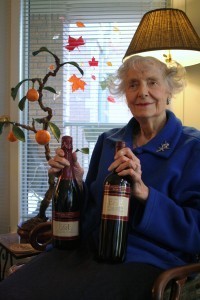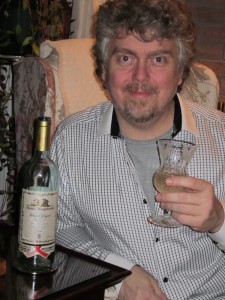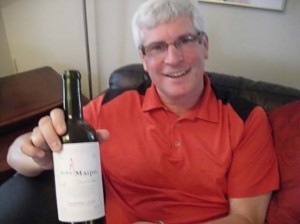Edward Willett's Blog, page 68
December 27, 2010
The Space-Time Continuum: Defining My Terms
When I was a high school debater, in the dim, distant past, I always began debates by defining my terms.
So let me begin this new regular column in Freelance the same way: by defining what I'm going to be talking about.
I'm going to be focusing in this column on what is referred to in polite literary society as "speculative fiction."
That's not a term I often use myself, since it is sometimes a euphemism used by writers horrified by the thought of getting icky "genre" germs all over their nice clean "literary" story, but it has its place as a useful umbrella, beneath which shelter three more specific genres, fantasy, science fiction and horror.
Of the three, the easiest to define, it seems to me, is horror. Indeed, it defines itself: it's fiction designed to invoke the emotional response that gives it its name. Some horror is completely, if disquietingly, realistic–think of a story of a serial killer on the loose–but much of it has a fantastic element–ghosts, vampires, etc.–which is why it is sometimes called "dark fantasy."
Which brings us to the definition of fantasy. Here's one I just made up, but I think it's pretty good: a story is a fantasy when the events within it violate physical laws as we know them and the story either makes no effort to justify that violation or else attributes it to magic or supernatural forces.
That's a broad definition; but then, fantasy is a broad genre, with deep roots, from Homer's Iliad and Odyssey to Shakespeare's The Tempest, Dickens's A Christmas Carol, and, of course, J.R.R. Tolkien's The Lord of the Rings.
Science fiction, though narrower in scope (since it attempts to at least pretend to conform to the laws of science) seems to also be much harder to define, unless you're happy with Margaret Atwood's infamous decree that science fiction is "talking squids in outer space."
Solipsistic definitions abound, such as Damon Knight's, that science fiction is what we point to when we say "science fiction," or Norman Spinrad's "science fiction is what science fiction editors buy."
Here's one I like, from Canada's best-known and most successful science fiction writer, Robert J. Sawyer: "Science fiction is a laboratory for thought experiments about the human condition; it lets us examine what it means to be human in ways that we simply can't in real life, because it would be unethical or impractical to conduct the experiments.
"Using literary devices such as displacement in time or space, or metaphorical others who let us exaggerate or isolate parts of the human psyche, science fiction allows us to see ourselves from odd angles, catching glimpses of truths that might otherwise be hidden from view."
So, when I write a novel (Marseguro) about genetically modified humans being persecuted by religious extremists in the far future, I am in some small way wrestling with issues that are arising now and will continue to arise into the future. I could deal with those same issues in a fantasy, where perhaps the humans would be modified by magic rather than science, but the issues, of otherness and alienation and religious persecution, would be the same.
But it would be much harder to wrestle with those questions in a mainstream novel, because we don't yet have any humans genetically modified so as to be distinct from the rest of us: and the moment I introduce them, I'm writing science fiction. In 20 years' time, though, they may well be the subject of mainstream fiction.
See how that works?
Having said all that, that's the "eat your vegetables" rationale for writing science fiction and fantasy. Here's another reason, and every bit as important: fiction is entertainment, and a ripping good yarn with intergalactic empires, aliens, spaceships, space princesses and, yes, talking squid, is my idea of great entertainment.
Science fiction and fantasy encompasses everything from grim near-future cautionary tales about cities flooded by rising oceans to madcap adventures about sword-swinging female barbarians battling giant spiders. All of time, space and imagination are your playground, which is why I've never understood why I'm so often asked why I write this stuff. To me the greater puzzlement is that so many writers don't!
But perhaps you do. Or want to. Or perhaps you're just curious about this field of literature, home of the never-was and the still-might-be, rather than the good old here-and-now.
Over the next few columns, I'll introduce you to the writers, books and trends making waves in "speculative fiction" (sigh), point you to some additional resources, provide some writing tips, and even offer up a few markets for your own fantastic fiction. I hope you enjoy the ride!
And finally, if you have any specific questions, I'm all ears (which in a fantasy or science fiction story is not necessarily metaphorical). Email me at ewillett@sasktel.net and watch for an answer in a future column!
December 11, 2010
Song of the Sword recommended in Saskatoon Star-Phoenix
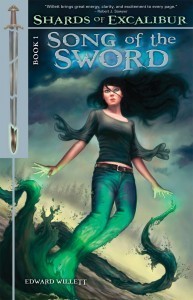 Song of the Sword got a nice mention in the Saskatoon Star-Phoenix today. In a feature called "Read aloud for holiday wonders," Beverley Brenna writes:
Song of the Sword got a nice mention in the Saskatoon Star-Phoenix today. In a feature called "Read aloud for holiday wonders," Beverley Brenna writes:
Favourite books for the holidays can be divided into two categories: older titles that withstand the test of time, and contemporary reads that more closely reflect today's reading audience.
Literacy research advocates reading aloud to children as the single most important thing a parent can do to support reading development, and the good news is: there's lots of titles available that interest adults as well as children, a far cry from the past when children's literature was generally didactic and difficult for adults to enjoy.
The following list is a combination of new titles and ones more tried and true, offering support for library visits as well as great gift ideas.
In the young adult category, she lists three titles: Suzanne Collins's bestelling The Hunger Games (soon to be a major motion picture), Gina McMurchy-Barber's Free as a Bird, shortlisted for the 2010 Governor General's Literary Award, and:
Edward Willett's Song of the Sword (Lobster Press, 2010), a highly original take on the King Arthur Legend, follows the adventures of two teen heroes on a Regina landscape. Book 1 of a series by a prolific Saskatchewan author.
Nice company to be in!
December 3, 2010
The Willetts on Wine: Madeleine Angevine and beyond: adventures in wine-tasting
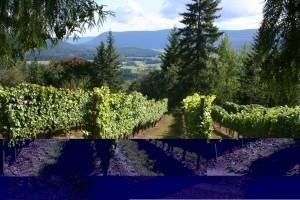 Adventure, discovery and exploring the unknown are all aspects of a great vacation—and a great wine-tasting.
Adventure, discovery and exploring the unknown are all aspects of a great vacation—and a great wine-tasting.
This summer we had both, when our trip to British Columbia brought us the Larch Hills Winery in the Salmon Arm area. Upon discovering at our hotel that the Okanagan's northernmost vineyards were only a few minutes' drive away, we headed out with GPS in hand.
A winding, switch-back road took us to the top of a mountain, where both a vineyard and a spectacular view awaited.
Larch Hills specializes (for obvious reasons) in cool-climate viticulture. We tasted several of the winemaker's offerings, and found, to our surprise, that our favourite was made from a seldom-heard-of grape variety called Madeleine Angevine.
A French grape that produces wines with Germanic style, it impressed with a full-on floral nose that reminded us of a bouquet of flowers…and a nicely balanced body and flavor that complemented that impression.
Inspired by our discovery, we decided on our return to Regina to continue our summertime wine exploration by looking for other unfamiliar varieties.
There are many single-varietal wines that are relatively new to consumers, such as Chenin Blancs and Argentinian Malbecs, but we wanted to find varietals we'd never even heard of.
There's no shortage of those. Worldwide, thousands of varieties of grapes are used to make wine. More than 60 varieties are grown in the Okanagan alone (though only about 20 of those receive the bulk of the attention).
Many unfamiliar wine grapes are varieties of Vitis labrusca or Vitis aestivalis, native to North America, rather than the Vitis vinifera of European fame. Concord grapes are an example of labrusca (and yes, Concord grapes are used to make wine). At a Missouri winery a few years ago we tasted Norton, a variety of Vitis aestivalis that is the cornerstone of that state's wine industry (and the state's official grape). Other less-familiar grape varieties may be hybrids of better-known varietals, or a cross between European and North American ones.
One easy way to find unfamiliar varieties is to look at wines from emerging wine-exporting areas such as Uruguay or Hungary, whose local vinifera grapes are just showing up on store shelves.
Or you can just wander through the liquor store reading labels, looking for grape names you don't recognize. Which is how we found our first two choices: a Greek Agiorgitiko and an Italian Negroamaro.
Agiorgitiko Boutari
Agiorgitiko is an important red grape in Greece, sometimes referred to "the noble red grape." We found this wine to be earthy and leathery on the nose and very smooth in the mouth, with lots of berry and a bit of spice (although not Shiraz-level). It was also very reasonably priced for its quality. Boutari, founded in 1879, has wineries all over Greece, and seeks to preserve and promote Greek varietals, shipping them all over the world…much to our benefit!
Mezzomondo Negroamaro Salento
"Negroamaro" means "black bitter" in Latin. A grape hailing from the "heel" of Italy, it's often blended. On its own, as we found it, it is well-rounded, without a lot of tannin, but perhaps better as an accompaniment to food than for sipping on its own.
Having taken a hit-or-miss approach for our first two unfamiliar wines, we next asked a couple of experts, who pointed us to two more wines, one from Italy, one from France.
Colli di Luni Vermentino
Vermentino, a white grape varietal grown on the island of Sardinia, off the coast of Italy, as well as in southern France, is being used for more and more New World wines. It was by far our favorite of our we've-never-heard-of-these-before quartet, light and fruity (peach and apricot), with an excellent balance of acid and sugar and delightful honey characteristics.
Domaine de Pellehaut
We hit the jackpot with this wine, which blends six wines (Ugni Blanc, Colombard, Gros Manseng, Chardonnay, Sauvignon and Folle Blanche), four of which were mostly unfamiliar to us.
Ugni Blanc is widely planted in France and, under the name St-Emilion, is the predominate grape in cognac. Gros Manseng is grown almost entirely in southwest France and is also most often part of a blend. As for Colombard, while its plantings are declining in France, it is increasing in popularity in California and South Africa.
On the nose, we detected pear; in the mouth, green apple, giving it a kind of "sharpness" on the palette.
"There are more wines in heaven and earth…than are dreamt of in your philosophy," Shakespeare famously wrote.
Or would have, had he been a wine writer.
Margaret Anne and Edward Willett drink wine, buy wine, taste wine, write about wine, conduct wine tastings, belong to three different wine clubs, and have more corkscrews than they can count.
Our readers recommend…
E&E Black Pepper Shiraz
We first tried E&E Black Pepper Shiraz at the International Wine and Food Festival at the Banff Springs Hotel. When we discovered that the Still was sold out at the on-site wine store we decided to try the Sparkling. It was our first sparkling red and it remains our favourite. Various vintages continue to deliver a complex dark red/purple wine full of ripe blackberry, coffee, dark chocolate and spice. It's a splurge wine, but well worth it.
Dr. Alice Goodfellow is a retired paediatrician who practiced in Regina during the 1950s and early 1960s. She is a long-time wine enthusiast, belonging to a number of local wine societies.
Santa Margherita Pinot Grigio Valdadige
Some people think that Pinot Grigio wines are too mass-produced and a little tasteless. (I've heard them described as the vodka of wines.) And then you taste something as wonderful as the Santa Margherita Pinot Grigio Valdadige, and everything changes. This is a great crisp wine, with excellent tang and lovely hints of citrus and quince. (Which, oddly, rhymes.) It's a little pricier than most Pinot Grigio, but the flavour and complement it brings to so many foods makes this well worth it. I love Italian wine. I love big bold flavours. For a white wine, this is perfect.
Robert Ursan, a composer, performer, music teacher and director, is Music Director for Do It With Class Young People's Theatre Co. and co-Artistic Director of The Golden Apple Theatre.
Vina Maipo Gran Devocion Carmenere/Syrah 2008
"Great Devotion" is what I tasted when I happened upon this blend from Chile. The soft tannins of the Carmenere embrace the peppery spice of the Syrah to produce a full, round, deep, dark, sensuous glass for your sipping pleasure. This wine is bold enough to pair nicely with the most savory of foods, red meats and lively cheeses, yet friendly enough to drink on its own. I'm not sure what percentage of each grape is used, but they got it right; and priced under $20, it's a bargain.
Gerry Bezaire is a New Home Specialist employed by Boychuk Homes in Saskatoon and a food and wine enthusiast.
December 1, 2010
Night Owl Reviews calls Terra Insegura "a very good read"
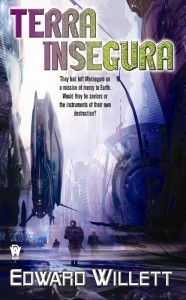 It's always nice to see a positive review of a book, even if said book has been out for a year and half, like Terra Insegura. Today a new review popped up at Night Owl Reviews, where reviewer Lilyraines writes:
It's always nice to see a positive review of a book, even if said book has been out for a year and half, like Terra Insegura. Today a new review popped up at Night Owl Reviews, where reviewer Lilyraines writes:
I found the book to have an intriguing take on genetic modification and what could go wrong. It also talks about obsession, arrogance, and a rigidly imposed belief that does not see anything beyond it…
Terra Insegura also shows through its characters how people who may not entirely trust each other can, in the end, respect each other and learn to work together.
A very good read.
November 16, 2010
Montreal Review of Books likes Song of the Sword
T he Montreal Review of Books, published by the Association of English-Language Publishers of Quebec, has a very nice review of Song of the Sword in its latest issue. (My publisher, Lobster Press, is based in Montreal.) Andrea Belcham writes:
he Montreal Review of Books, published by the Association of English-Language Publishers of Quebec, has a very nice review of Song of the Sword in its latest issue. (My publisher, Lobster Press, is based in Montreal.) Andrea Belcham writes:
Willett's novel will please fantasy junkies with its intricate details; yet there's also an appealing poetry to Ariane's story, best manifested when she learns to use her powers to merge with water and transport herself wherever it flows. Song of the Sword is a unique twist on the old subjects of teenage rebellion and self-discovery.
Another online interview…
 …this time with Casey at The Bookish Type.
…this time with Casey at The Bookish Type.
It begins:
What inspired you to write The Shards of Excalibur? Have you always had an interest in Arthurian legend?
I have always had an interest in things Arthurian, or at least since I read T.H. White's The Once and Future King as a kid, followed up with Mary Stewart and any number of other retellings since. But what inspired The Shards of Excaliburwasn't initially my interest in the Arthurian legends, but a very specific place: Wascana Lake, the man-made lake in the heart of Regina where Ariane sees the staircase descending into the water and meets the Lady of the Lake for the first time. I live near Wascana Lake and have for 20 years, so I'm often walking around it. One day I was particularly taken with a heavy mist turning golden in the morning light, and thought, "It looks mystical. Anything could be hidden in that mist." And then I thought, "Well, why not?"
November 8, 2010
WORD for Teens reviews Song of the Sword…
 …and generally likes it. Nicole, the young proprietor of WORD for Teens, calls it "very well executed" and "a fun read" and also writes, in part:
…and generally likes it. Nicole, the young proprietor of WORD for Teens, calls it "very well executed" and "a fun read" and also writes, in part:
I thought, for the concept that was being used, it was very well done indeed. I'm never going to be a fan of evil Merlin. I love Merlin far too much. But I thought Willett did an excellent job here – it's not that Merlin is evil so much as stuck in at time that's not his own, with an idea that he doesn't consider evil…
I like Ariana – she's got quite a bit of personality and spunk, and I like that. I wish she didn't get a hold of her powers quite so fast, but hey, she was pressed for time. Wally is definitley my favorite character. He's got a bit of King Arthur potential, but he's so very quirky. He fences. I like him. And I sense his sister becoming a bit of a Morgan le Fay character, which should prove to be entertaining.
Read the whole thing. And WORD for Teens looks like a great source in general for a fresh look at fiction for teens.
Song of the Sword first signing event: Chapters Regina
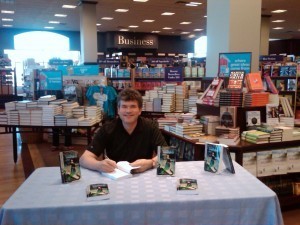 Here I am signing Song of the Sword at Chapters in Regina on Saturday. This was not only the first time I sat and sold copies of the book and autographed them, it was the first time I'd even seen copies of the actual book. It's shinier than the ARC! Plus it has a nice blurb in the back of it promoting book two in the series, Twist of the Blade.
Here I am signing Song of the Sword at Chapters in Regina on Saturday. This was not only the first time I sat and sold copies of the book and autographed them, it was the first time I'd even seen copies of the actual book. It's shinier than the ARC! Plus it has a nice blurb in the back of it promoting book two in the series, Twist of the Blade.
The only odd thing about this photo: it makes the store look deserted. In fact, it was very busy and I sold and signed more than a dozen books in the couple of hours I was there.
For bonus marks, spot my daughter Alice in this picture…
November 2, 2010
Fine Lifestyles Regina has feature article about me
 Yes, I know, I edited the thing, but honestly, the story wasn't my idea: it was publisher Randy Liberet's. And since I have a new book coming out (November 15 is the new release date for Song of the Sword) I'd have to have been an idiot to let modesty get in the way of promotion. And so I assigned Mark Claxton, one of the best writers available to me, the task of interviewing me and making me sound interesting. Remarkably, I think he succeeded.
Yes, I know, I edited the thing, but honestly, the story wasn't my idea: it was publisher Randy Liberet's. And since I have a new book coming out (November 15 is the new release date for Song of the Sword) I'd have to have been an idiot to let modesty get in the way of promotion. And so I assigned Mark Claxton, one of the best writers available to me, the task of interviewing me and making me sound interesting. Remarkably, I think he succeeded.
The feature is called "A fantastic life" and begins thusly:
Edward Willett has a few things on his plate these days.
In fact, he could probably use a few more plates.
Known in these pages as the editor of Fine Lifestyles Regina, and sister magazines Fine Lifestyles Saskatoon, Fine Homes Regina and Fine Weddings Regina,Willett is also a writer of science books, children's fiction and biographies, and a nationally recognized science fiction novelist. In the weeks leading up to publication of this edition, he was also completing a manuscript that was due to his publisher, working on the rewrite of another novel, and trying to make progress on a third book in which a publisher had shown interest.
Oh, and did we mention he is also an actor and singer?
"I'm on the fly all the time," Willett says during a recent interview that is interrupted at least four times by his ringing cell phone. "I get up in the morning and think, 'Okay, what do I have to do today?'"
As a freelance editor, writer and performing artist, Willett has worked 17 years for the privilege of being so busy. In 1993, he walked away from a full-time position as communications officer for the Saskatchewan Science Centre.
"I had an offer from Prairie Opera in Saskatoon to do a two-month school tour," Willett recalls. "So I knew I had two months of paying work coming.
"That seemed like enough," he adds with a laugh. "I was perhaps a little braver than I realized."
Final Willett-edited Fine Lifestyles Regina and Fine Lifestyles Saskatoon now online
You can now read the final issues of Fine Lifestyles Regina and Fine Lifestyles Saskatoon that I edited online. Just follow the links!
Here are the covers again:

